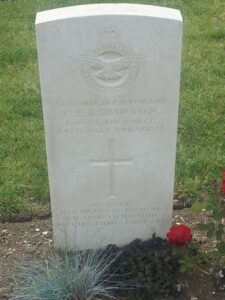Llanelwedd is a small village situated on the right bank of the Wye, immediately north of Builth Wells. The village is centred around the crossroads of the A470 from Rhayader, the A483 from Llandrindod Wells and Welshpool, and the A481 from Worcester. The village is the site of the Royal Welsh Showground, and contains a fine mediaeval Parish Church, which is dedicated to St. Matthew. Within the Church are individual memorials to men of the Parish who fell during three wars: one during the Boer War; one in World War One and another in World War Two.
The First Anglo Boer War, 1880-1881
Herbert Augustine Christopher Harrison, Lieutenant, 9th Regiment. Christopher was born at Peldon Rectory, Essex on 21 March 1856, the son of Reverend Christopher Robert Harrison and Mrs Jessie Harrison (née Mundell). His parents had been married at St. Matthew’s, Llanelwedd. Herbert was originally commissioned into the 89th Regiment of Foot. He was then posted to the 9th Regiment, but became Adjutant to the 94th Regiment, under Colonel Anstruther. The regiment embarked for South Africa in spring 1879 and saw action against the Zulus at the Battle of Ulundi in July 1879. The regiment marched into the Transvaal and took part in the successful attack on Sekukuni’s stronghold on 28 November 1879 during the Basuto Gun War. The regiment remained in South Africa, where two of its companies were attacked at the Bronkhorstspruit River on 20 December 1880, in the opening clash of the First Boer War. Christopher was among four officers and 71 other ranks killed during the battle. He was 24 years old.
The Great War, 1914-1918
Cyril Evan Robinson, Second Lieutenant, Royal Air Force. Cyril was born at Manchester on 12 August 1899, the son of Evan George Robinson and Mary Louise Robinson (nee Griffiths). He worked as an assistant ironmonger prior to enlisting into the Royal Flying Corps and after gaining his pilots wings was commissioned in December 1917, before being posted to 27 Squadron, RFC in France. The squadron had originally been equipped with the Martinsyde Elephant fighter, but switched to a bomber role and re-equipped with Airco DH.4s, flying missions in support of the British offensive at Cambrai, and low-level missions against the attacking German troops during the Spring Offensive of 1918. It started to receive De Havilland 9 bombers in July 1918, but as these proved to be inferior to the DH.4, managed to keep some of its DH.4s until the end of the war. Cyril joined the squadron in July 1918. On 24 July 1918 he took off from the squadrons base at Ruisseauville, a village about 20 miles west of Bethune, flying DH9, serial C6340, with Second Lieutenant William Houston Telfer aboard. Not long into their flight, at an altitude of 600 feet the aircraft stalled and crashed into the ground near Coulommiers, killing both men instantly. Cyril was just 19 years old and is buried next to William at Coulommiers Communal Cemetery, France. He is also commemorated in Builth Wells Parish Church.

World War Two, 1939-1945
John Kenneth Glasscodine, Private, 14989830, Welch Regiment. John was born in Oswestry, the son of Wilfred Henry Portman Glasscodine and Jane Annie Maud Glasscodine (nee Wynne). The family lived at Llanelwedd prior to the war, as Wilfred was station master at Builth Road. John enlisted into the army and was posted to the 4th Battalion, Welch Regiment. The regiment was the Carmarthenshire Territorial unit and was attached to the 53rd (Welsh) Division. It crossed the Channel to land in Normandy at the end of June 1944, and took part in the fighting in the Bocage, before the Allies broke out of Normandy, and then took part in the advance through France into Belgium and Holland. The 53rd Division crossed the German frontier near the massive Reichswald Forest and took part in heavy fighting in the area from 6 February 1945, tasked with clearing the northern half of the forest. On St Davids Day, 1945, the 4th Welch crossed the River Niers in assault boats, ordered to capture the hill overlooking the Rhine crossing at Wesel. The 4th Welch moved forwards and launched the attack at noon on 6 March, and was met with heavy fire from German paratroopers hidden in the woods. By late afternoon the battalion had taken its objectives, but then became hit by mortar and artillery fire. John was wounded during the attack and died on the following day, 7 March 1945, aged 19. He is buried in Reichswald Forest War Cemetery, Germany.
